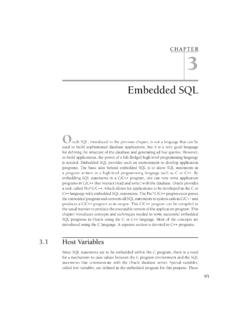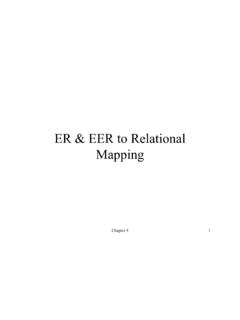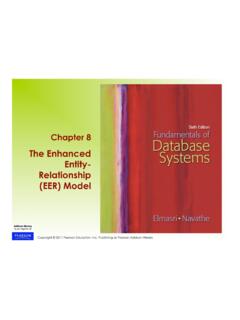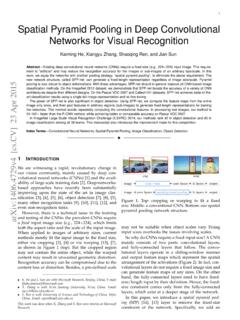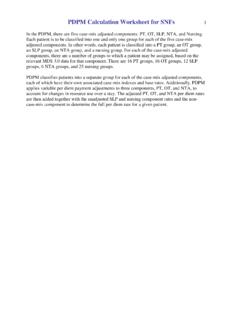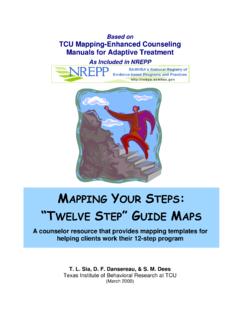Transcription of ER & EER to Relational Mapping - Georgia State University
1 Chapter 91ER & EER to Relational Mapping Addison Wesley Longman, Inc. 2000, Elmasri/Navathe, Fundamentals of Database Systems, Third EditionNumberFnameDEPENDENTM initLnameNameAddressSexSalarySsn___EMPLO YEEB dateWORKS_FORS tartDateMANAGESN umberOfEmployeesNameLocationsDEPARTMENTC ONTROLSPROJECTNameLocationNumber_____WOR KS_ONDEPENDENTS_OFN1 HoursNNameSexBirthDateRelationshipN11 NsupervisorsuperviseeSUPERVISION11N1 Figure diagram for the company 92 Step 1:For each regular entity type E Create a relation R that includes all the simple attributes of E. Include all the simple component attributes of composite attributes. Choose one of the key attributes of E as primary key for R. If the chosen key of E is composite, the set of simple attributes that form it will together form the primary key of R.
2 Addison Wesley Longman, Inc. 2000, Elmasri/Navathe, Fundamentals of Database Systems, Third EditionDNAMEDEPARTMENTDNUMBERMGRSSNMGRST ARTDATEFNAMEMINITLNAMESSNBDATEADDRESSSEX SALARYSUPERSSNDNOEMPLOYEEDEPT_LOCATIONSD NUMBERDLOCATIONPNAMEPROJECTPNUMBERPLOCAT IONDNUMESSNWORKS_ONPNOHOURSDEPENDENTESSN DEPENDENT_NAMESEXBDATERELATIONSHIPF igure diagram for the COMPANY relationaldatabase schema; the primary keys are 93 Step 2:For each weak entity typeWwith owner entity type E Create a relation R, and include all simple attributes and simple components of composite attributes of W as attributes of R. In addition, include as foreign key attributes of R the primary key attribute(s) of the relation(s) that correspond to the owner entity type(s).
3 Addison Wesley Longman, Inc. 2000, Elmasri/Navathe, Fundamentals of Database Systems, Third EditionDNAMEDEPARTMENTDNUMBERMGRSSNMGRST ARTDATEFNAMEMINITLNAMESSNBDATEADDRESSSEX SALARYSUPERSSNDNOEMPLOYEEDEPT_LOCATIONSD NUMBERDLOCATIONPNAMEPROJECTPNUMBERPLOCAT IONDNUMESSNWORKS_ONPNOHOURSDEPENDENTESSN DEPENDENT_NAMESEXBDATERELATIONSHIPF igure diagram for the COMPANY relationaldatabase schema; the primary keys are 94 Step 3:For each binary 1:1 relationship type R Identify the relations S and T that correspond to the entity types participating in R. Choose one of the relations, say S, and include as foreign key in S the primary key of T. It is better to choose an entity type with total participation in R in the role of S.
4 Include the simple attributes of the 1:1 relationship type R as attributes of S. If both participations are total, we may merge the two entity types and the relationship into a single relation. Addison Wesley Longman, Inc. 2000, Elmasri/Navathe, Fundamentals of Database Systems, Third EditionDNAMEDEPARTMENTDNUMBERMGRSSNMGRST ARTDATEFNAMEMINITLNAMESSNBDATEADDRESSSEX SALARYSUPERSSNDNOEMPLOYEEDEPT_LOCATIONSD NUMBERDLOCATIONPNAMEPROJECTPNUMBERPLOCAT IONDNUMESSNWORKS_ONPNOHOURSDEPENDENTESSN DEPENDENT_NAMESEXBDATERELATIONSHIPF igure diagram for the COMPANY relationaldatabase schema; the primary keys are 95 Step 4:For each regular binary 1:N relationship type R Identify the relation S that represents the participating entity type at the N-side of the relationship type.
5 Include as foreign key in S the primary key of the relations T that represents the other entity type participating in R. Include any simple attributes of the 1:N relationship type as attributes of S. Addison Wesley Longman, Inc. 2000, Elmasri/Navathe, Fundamentals of Database Systems, Third EditionDNAMEDEPARTMENTDNUMBERMGRSSNMGRST ARTDATEFNAMEMINITLNAMESSNBDATEADDRESSSEX SALARYSUPERSSNDNOEMPLOYEEDEPT_LOCATIONSD NUMBERDLOCATIONPNAMEPROJECTPNUMBERPLOCAT IONDNUMESSNWORKS_ONPNOHOURSDEPENDENTESSN DEPENDENT_NAMESEXBDATERELATIONSHIPF igure diagram for the COMPANY relationaldatabase schema; the primary keys are 96 Step 5:For each binary M:N relationship type R Create a new relation S to represent R. Include as foreign key attributes in S the primary keys of the relations that represent the participating entity types; their combination will form the primary key of S.
6 Also, include any simple attributes of the M:N relationship type as attributes of S. Addison Wesley Longman, Inc. 2000, Elmasri/Navathe, Fundamentals of Database Systems, Third EditionDNAMEDEPARTMENTDNUMBERMGRSSNMGRST ARTDATEFNAMEMINITLNAMESSNBDATEADDRESSSEX SALARYSUPERSSNDNOEMPLOYEEDEPT_LOCATIONSD NUMBERDLOCATIONPNAMEPROJECTPNUMBERPLOCAT IONDNUMESSNWORKS_ONPNOHOURSDEPENDENTESSN DEPENDENT_NAMESEXBDATERELATIONSHIPF igure diagram for the COMPANY relationaldatabase schema; the primary keys are 97 Step 6:For each multi-valued attribute A Create a new relation R that includes an attribute corresponding to A plus the primary key attribute K (as a foreign key in R) of the relation that represents the entity type or relationship type that has A as an attribute.
7 The primary key of R is the combination of A and K. If a multi-valued attribute is composite, we include its components. Addison Wesley Longman, Inc. 2000, Elmasri/Navathe, Fundamentals of Database Systems, Third EditionDNAMEDEPARTMENTDNUMBERMGRSSNMGRST ARTDATEFNAMEMINITLNAMESSNBDATEADDRESSSEX SALARYSUPERSSNDNOEMPLOYEEDEPT_LOCATIONSD NUMBERDLOCATIONPNAMEPROJECTPNUMBERPLOCAT IONDNUMESSNWORKS_ONPNOHOURSDEPENDENTESSN DEPENDENT_NAMESEXBDATERELATIONSHIPF igure diagram for the COMPANY relationaldatabase schema; the primary keys are 98 Step 7:For each n-aryrelationship type R, n>2 Create a new relation S to represent R. Include as foreign key attributes in the S the primary keys of the relations that represent the participating entity types.
8 Also include any simple attributes of the n-aryrelationship types as attributes of S. The primary key for S is usually a combination of all the foreign keys that reference the relations representing the participating entity types. TERNARY RELATIONSHIPS Addison Wesley Longman, Inc. 2000, Elmasri/Navathe, Fundamentals of Database Systems, Third EditionSNAME_____SUPPLIERSUPPLYSNAMEPROJ NAMEPARTNOQUANTITYPARTNO_____PARTPROJNAM E_____PROJECTF igure the n-ary relationship type SUPPLY from Figure (a).Chapter 99 However, if the participation constraint (min,max) of one of the entity types E participating in the R has max =1, then the primary key of S can be the single foreign key attribute that references the relation E corresponding to E This is because , in this case, each entity e in E will participate in at most one relationship instance of R and hence can uniquely identify that relationship 910 Step 8:To convert each super-class/sub-classrelationship intoa Relational schema you must use one of the four options available.
9 Let C be the super-class, K its primary key and A1, A2, .., Anits remaining attributes and let S1, S2, .., Smbe the 911 Option 8A (multiple relation option): Create a relation L for C with attributes Attrs(L) = {K, A1, A2, .., An} and PK(L) = K. Create a relation Lifor each subclass Si, 1 <i < m, with the attributes ATTRS(Li) = {K} U {attributes of Si} and PK(Li) = K. This option works for any constraints: disjoint or overlapping; total or 912 Option 8B (multiple relation option): Create a relation Lifor each subclass Si, 1 <i < m, with ATTRS(Li) = {attributes of Si} U {K, A1, A2, .., An}PK(Li) = K This option works well only for disjoint and total constraints. If not disjoint, redundant values for inherited attributes.
10 If not total, entity not belonging to any sub-class is lost. Addison Wesley Longman, Inc. 2000, Elmasri/Navathe, Fundamentals of Database Systems, Third EditionEMPLOYEESSN FName MInit LName BirthDate Address JobTypeSSN TypingSpeedSECRETARYSSN TGradeTECHNICIANSSN EngTypeENGINEER(a)CARV ehicleId LicensePlateNo Price MaxSpeed NoOfPassengersVehicleId LicensePlateNo Price NoOfAxles TonnageTRUCK(b)EMPLOYEESSN FName MInit LName BirthDate Address JobType TypingSpeed TGrade EngType (c)PARTPartNo Description MFlag DrawingNo ManufactureDate BatchNo PFlag SupplierName ListPrice(d)
